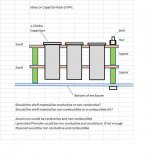toolnut
Stainless
- Joined
- Aug 3, 2005
- Location
- Kingsport, TN
I have been trying to find a good way to mount run and start capacitors into a compact group for my latest RPC design. I am building some 10 hp RPCs and am using Hoffman 16 x 20 x 8 enclosures. I am thinking about a rack consisting of two shelves seperated by spacers and bolted to the enclosure bottom. Each shelf will have 1-3/4" dia holes for the capacitors and the capacitors will be hanging by their lips or will be sitting on the enclosure bottom.
I need some advice on the material for the shelves. I made a sketch of the arrangement and attached it here.
I could use Aluminum, laminated phenolic or some other plastic. I currently have my prototype made of Luan plywood as it is easy to work and cheap for trial and error work.
Bruce Norton
I need some advice on the material for the shelves. I made a sketch of the arrangement and attached it here.
I could use Aluminum, laminated phenolic or some other plastic. I currently have my prototype made of Luan plywood as it is easy to work and cheap for trial and error work.
Bruce Norton













